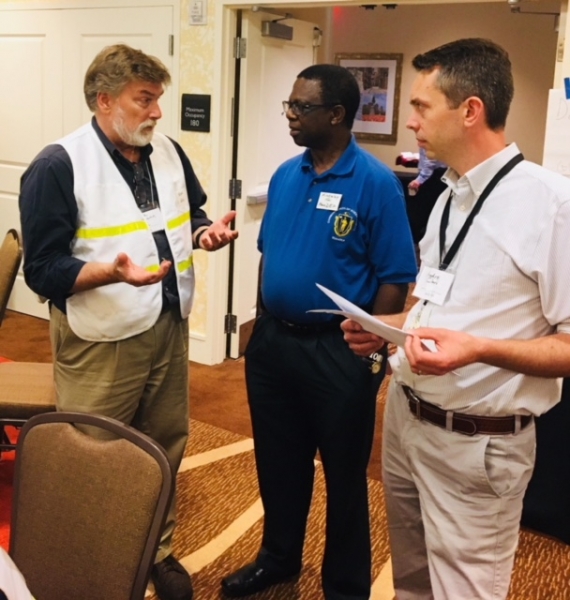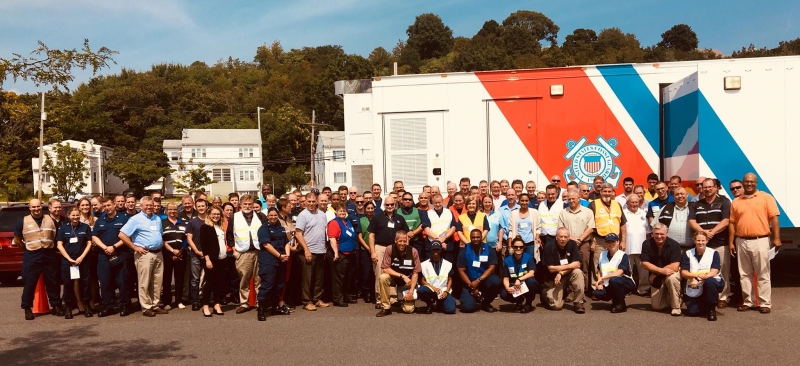The Chelsea River, which sits at the northern end on Boston Harbor, is home to the vast majority of oil storage in the Boston area. Among other things, it supplies most of the fuel to Logan International Airport. While the currents are slow, the river is narrow and requires transit through two bridges, often with marine traffic in the area.
Therefore, the probability of an oil release from a ship or one of the terminals is higher in the river than in any other part of Boston Harbor. For this reason, the U.S. Coast Guard Sector Boston decided to hold an exercise focused on the challenges offered by the Chelsea River (more commonly known as Chelsea Creek).

Last month, NOAA joined the U.S. Coast Guard at the Boston Harbor to run a simulated oil release exercise. The scenario entailed 1,000,000 gallons of oil being released from a terminal following storm damage into containment, a large, unknown portion of which flowed into the river. As a lead up to the exercise, the senior scientific support coordinator for this region conducted a day of classroom and field training for the Coast Guard, state agencies, and a local nongovernmental, community organization in order to highlight the unique challenges posed by oil spills on urban shorelines. During the exercise, NOAA provided scientific support through trajectories, resources-at-risk reports, and oil fate models for the simulated release and used its expertise to advise the federal on-scene coordinator.
The Chelsea River and its environs represent a common, but under-exercised challenge; it is located in a densely populated urban setting. This was one of reason that an urban setting was instrumental to the design of this particular exercise. Add to this the significant threat posed by shipping and fuel storage in the river and the logistical and economic consequences of closing this concentrated energy corridor due to a major spill cleanup and the motivation for this scenario becomes obvious.
The public typically imagines oil spills along sand beaches or on rocky shores or floating offshore, but the fact is that most small spills (and many major spills) happen where industry and recreational activities coexist — in urban areas. For Boston Harbor alone, there have been several larger spills in the past, among the most notable was the tank vessel Posavina, which was punctured by the bow of its assisting tug at a terminal in Chelsea River, releasing more than 50,000 gallons of fuel in the Chelsea River on June 8, 2000. Another incident that took place near the site of the recent drill was the Irving Oil Terminal incident, when on March 9, 2006, a fuel line released 20,000 gallons into the Chelsea River. These incidents and others in densely populated areas highlight the need for regular training and increased awareness of the unique nature of the city shorelines and populations.
These densely populated areas pose planning, operational, and outreach challenges that require different approaches. For example, while vapor protection for workers is always a concern, rarely is odor (very low concentrations of vapors) an issue for the command. In an urban setting, non-toxic level odors can generate great public outcry and worry. Understanding how to communicate to a population that perceives itself at risk is critical.
Another example of urban spill response complexities involves the appreciation of scarce natural resources, regardless of their condition. At the head of the Chelsea River is a small marsh known as Mill Creek. The wetland, by almost any measure, is degraded and struggling. It suffers decades of neglect and abuse, runoff from local busy roadways, litter and other insults. However, this Oliver Twist of a marsh, mistreated and alone, is an oasis of coastal green along the shoreline of Boston Harbor. Its singularity, its rarity, makes it one of the highest priorities in the Harbor. It’s not protected for its beauty (although it is beautiful) nor its contribution to the local ecosystem (although it contributes), it’s protected because it’s the only one of its kind and the residents along the Chelsea River cherish it for that reason, among others.
The Chelsea River exercise had several objectives, many common to most U.S. Coast Guard led drills. It exercised the deployment of boom and the management of a response using the Incident Command System, including a mock press conference. It gave responders from many federal, state and local agencies (Coast Guard, NOAA, the Environmental Protection Agency, the U.S. Fish and Wildlife Services, Massachusetts Department of Environmental Protection, Boston and Revere Fire Departments, to name only a few) an opportunity to network and come together as a team, as well as incorporating community action groups and local stakeholders. However the most important objective, at least for this participant, was to provide an object lesson about the sensitivities of shorelines that, at first, seem hard, resilient and forgettable. It was to raise the awareness of responders and decision-makers to the overlooked treasures and dangers of an urban marine landscape.

